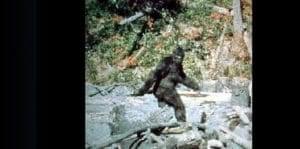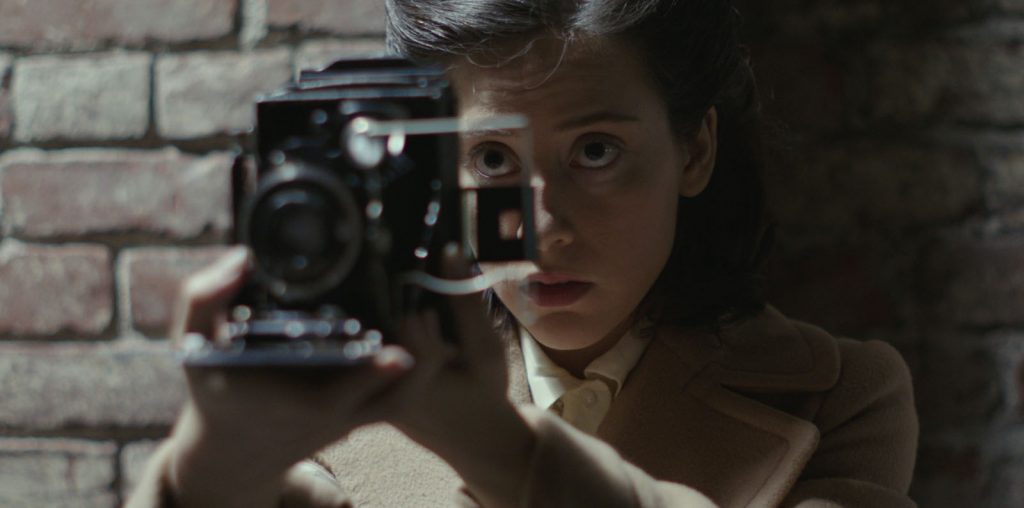
Former Film Threat contributing editor Phil Hall’s new book “The Weirdest Movie Ever Made: The Patterson-Gimlin Bigfoot Film,” details the history of the 59-second footage purportedly showing the elusive Sasquatch walking at Bluff Creek in the northern California woods. This excerpt of the book details how Roger Patterson and Bob Gimlin, the ex-rodeo riders from Yakima, Washington, who shot the footage, alerted the world of their film.

The first public acknowledgement of the Patterson-Gimlin Film occurred on October 21, 1967, the day after the Bluff Creek encounter. On that Saturday morning, readers of the Humboldt Times-Standard were greeted with a page-one exclusive carrying the headline “Mrs. Bigfoot Is Filmed!”
The newspaper’s coverage did not carry a byline, but Sasquatch researcher Christopher L. Murphy identified the possible author as Al Tostado, a reporter for the newspaper. We do not know if Patterson’s inquiry was a cold call or if he had been in contact with the reporter prior to going into the forest. In any event, the reporter seemed to be familiar with the folklore surrounding the Sasquatch and the XXL-sized footprints that kept turning up in the area.
In retrospect, it seems curious that the newspaper would run the story, let alone put in on its front page. For starters, Patterson and Gimlin had no still photographs or other physical evidence to back the claim of a Sasquatch encounter. The article also planted many of the seeds of confusion that would baffle and bother scholars trying to make sense of this story. This is obvious from the over-excited first paragraph: “A Yakima, Wash., man and his Indian tracking aide came out of the wilds of northern Humboldt County yesterday to breathlessly report that they had seen and taken motion pictures of ‘a giant hominoid creature.’”
This article established the story that Patterson was the brains, heart, and soul of the expedition, with Gimlin relegated to sidekick status. As per the journalistic protocol of that distant era, Gimlin is defined by his race.
The article spends two paragraphs describing Patterson’s authorship of the book “Do Abominable Snowmen of America Really Exist?” along with his “50 tapes of interviews” with people who claimed to have seen Sasquatches and the “eight years on the project” that he devoted to the search. Gimlin’s knowledge of the subject is ignored, and he is only mentioned as having “been associated with Patterson for a year.”
“I could see its breasts hanging down and they flopped when it moved…”
Furthermore, the article stated that Patterson claimed Gimlin released their horses in the commotion of the encounter, although Gimlin would later contradict that. Patterson also affirmed the Sasquatch’s gender by saying, “I could see its breasts hanging down and they flopped when it moved” – but Gimlin would later insist they were unaware of the breasts until they reviewed the film footage. Patterson told the reporter that the film was “already on its way by plane to his hometown for processing,” but there is no record of a chartered flight flying the film to Yakima and no clear evidence that Patterson had funds with him to pay for a last-minute charter flight. Patterson also identified Al DeAtley as a “partner” who “helped finance Patterson’s expeditions,” ignoring the fact that DeAtley was his brother-in-law.
The article also quoted Patterson as claiming the Sasquatch encounter happened at 1:30 p.m., adding that it was eight hours prior to the interview with the reporter. However, there has been uncertainty regarding just when the Sasquatch was seen. Assuming the reporter was called at 9:30 p.m., the turnaround time for writing and editing the article and setting it as a page one story would have been uncommonly rapid, especially for a Saturday edition of a small daily newspaper.
Gimlin was never quoted in the article; whether Patterson intentionally kept him off the phone call or whether the reporter chose not to speak with the “Indian tracking aide” is not known. As a result, Patterson was the center of the attention in the first media mention of the footage.
Gimlin drove the pair back to Yakima – he would later claim that Patterson was a terrible driver and he did not trust him to get them home in one piece. Just when they returned, either on late Saturday, October 21 or early Sunday, October 22, is not known. But Gimlin, reported to be exhausted from the drive, went straight to his house to collapse into a lengthy sleep.
On October 22, Al DeAtley arrived at Patterson’s home with the film from Bluff Creek. They were joined by Canadians John Green and René Dahinden, respectively a newspaper publisher and a Swiss-born government forestry officer, who shared an enthusiasm for Sasquatch research, along with a Californian Sasquatch researcher named Jim McClarin. In Patterson’s basement, the men viewed the Bigfoot footage and held a lengthy discussion on how to proceed with the film.
Green and Dahinden convinced Patterson that the film should be taken for review before anthropologists at the University of British Columbia in Vancouver. Their argument was solid: The Sasquatch was a more familiar aspect of the British Columbian folklore, and the possibility of documentary evidence would be treated with a greater degree of respect than if the footage was taken to an East Coast university where the Sasquatch was an unknown entity. Joining this cause was Don Abbott, who was able to arrange for his institution to study the film.
“…thought they were looking at a species of creature unknown to modern science.”
Starting on October 23, Abbott helped to stir publicity for the film by alerting the media in British Columbia about the existence of the film. A Vancouver radio show host named Jack Webster agreed to interview Patterson and Gimlin when they arrived in the city. During this interview, Webster was the first person to publicly question why Patterson shot the Sasquatch with his camera and not with a gun. “I don’t think you would have if you had seen the humanness of it,” Patterson responded. “I think it would take a person with a little bit of murder in his heart to shoot something like this.”
On October 26, a screening was arranged at the University of British Columbia. For all of the hoopla that was generated about the presentation, the audience turnout was rather scant. Historian Christopher L. Murphy noted there were only two university professors, three museum scientists including Abbott, along with Patterson, Gimlin, Green, Dahinden and another Sasquatch researcher named Bob Titmus. Patterson provided the plaster casts of the footprints collected from the Bluff Creek site for review.
The screening, to be charitable, was a disaster. Frank Beebe, a museum scientist, would recall the presentation in a December 1967 interview by dismissing the creature in the film as “a phony and a fake.” Ian McTaggart-Cowan, one of the university scientists who was also present, looked back at the screening in a 1983 interview by stating no one present “thought they were looking at a species of creature unknown to modern science.”
Returning home from Vancouver, Patterson loaned a copy of the footage to the news department at KIMA, the television station serving the Yakima market. The station broadcast a news item on the alleged encounter and offered a glimpse of the Bluff Creek Sasquatch footage. This represented the first telecast of the Patterson-Gimlin film.
The Yakima Herald, the local daily newspaper, ran a brief item on the Bluff Creek Sasquatch with an October 27, 1967, dateline. The article mentioned “25 feet of motion picture film” but offered no imagery. However, a photo of Patterson and Gimlin admiring the plaster casts of the Sasquatch’s footprints ran with the story, which was picked up by the Associated Press news wire. It is not certain how many newspapers reran the story via the Associated Press, but this would have been the first wide scale U.S. media acknowledgment of what transpired.
Phil Hall’s “The Weirdest Movie Ever Made: The Patterson-Gimlin Bigfoot Film” is available October 1st from BearManor Media.



glad I found your article, the time given by Patterson (1:30pm) would have to be the first (and seemingly most accurate) of when the filming occurred. What’s distressign is that the famous Argosy article just 3 months later by Sanderson opens with “At 3:30pm …”. Kind of strange that each time is on the half-hour, more precise than one would think if it was just guesswork (unless Gimlin’s truck had a clock in it and they checked the time when they returned for the plaster – seems doubtful).